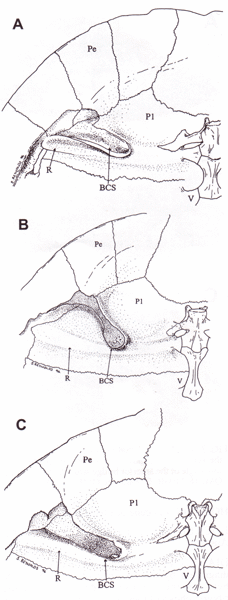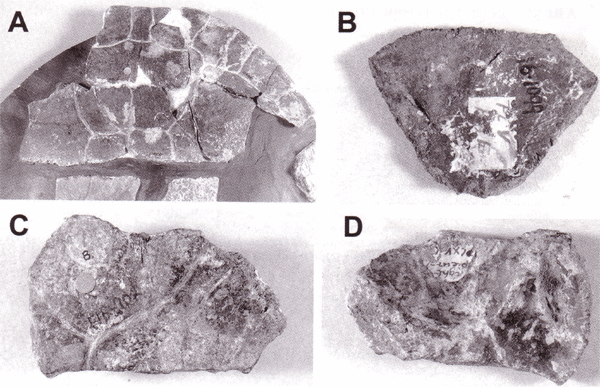| |
The four species synonymised above are, in this paper, recognised as a single diagnosable taxon, with C. uberima being the senior-most available name (page priority). The genus Chelymys has been synonymised in recent years with Emydura (Cogger et al., 1983), the genus Pelocomastes is considered here a junior synonym of the genus Elseya, Gray 1867.
These species were previously differentiated largely by shell ornamentation (Gaffney, 1981), an unsatisfactory method since this character can vary significantly even within a single population of turtles. The lectotype of Chelymys antiqua is not easily diagnosable. Based on the morphology of the pygal bone of extant species it would be attributed to almost any short-necked taxon in that the posterior suture of the ileum is in close proximity to the vertebral column. The Elseya latisternum group and Pseudemydura have a triangular suture on the pygal (unpublished data) ruling out these taxa. This pygal is either Elseya or Emydura but without the eighth pleural this is impossible to identify further (Thomson & MacNess, 1999). As there are no other diagnostic features between these specimens, all are considered as a single diagnosable taxon and assigned to Elseya.
Rheodytes devisi sp. nov.
Etymology. This species is named for C.W. de Vis who described most of the material presented in this paper as well as many other taxa within Australia.
Material. Holotype: QMF16-1106B (Fig. 3A-B). PARATYPES: QMF16-1106A, C-D.
Horizon. Pliocene or Pliestocene.
Locality. Darling Downs, Queensland, Australia.
Diagnosis. The genus Rheodytes can be diagnosed by the presence of a 10 to 15 degree angle between the anterior bridge strut and the rib/gomphosis of pleural one and by the parallel sutural edges of the bridge strut with intervening deep socket like sutural surface (Thomson et al., 1997)(Fig. 2C). This combination of characters is unique to this genus and is present in the both specimens of first pleurals in the type series (Fig. 3B-C). The species Rheodytes devisi is diagnosed by its thicker better formed carapacial bones. Deeper insertion of the anterior bridge strut suture and the failure of the anterior bridge strut to either break through , or come close to breaking through, the pleural surface.
Discussion. Material consists of: QMF16-1106B right first pleural, almost complete (Fig. 3A-B); QMF16-1106C distal section of a right first pleural (Fig. 3C); QMF16-1106D left partial pleural of indeterminate position but likely from the seventh pleural.
Rheodytes leukops is an inhabitant of the Fitzroy River in eastern Queensland, whereas R. devisi is found in the western flowing drainages of the Darling Downs. Among the extant taxa Rheodytes leukops can be identified by its extremely thin shell, to the point that the ileum and bridge strut often break through the carapace, all other genera have thicker shells ranging from the Elseya latisternum group through to the Emydura and Elseya. |
|
R. devisi has a thick shell much like other short-necked species and hence it can be diagnosed from its congener R. leukops. The species are allochronic and allopatric and appear to have inhabited differing environments.

Fig. 2. Comparative diagrams of representative short-necked genera. A. Elseya latisternum; B. Elseya dentata; C. Rheodytes leukops. Showing the angle between the rib/gomphosis (R) and the anterior bridge strut suture (BCS) on the first pleural (P1). (From Thomson et al., 1997).
|
|


